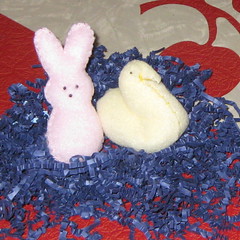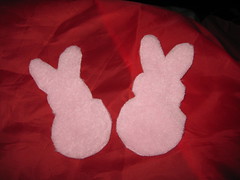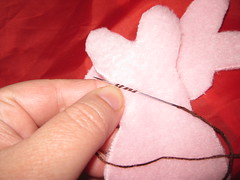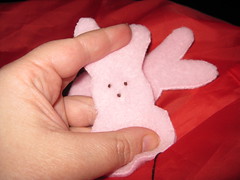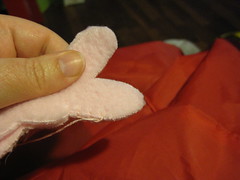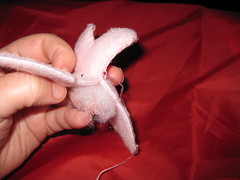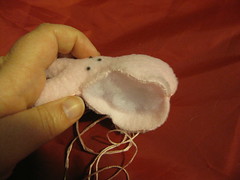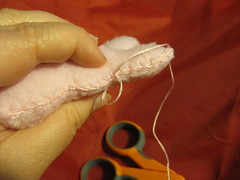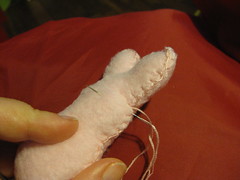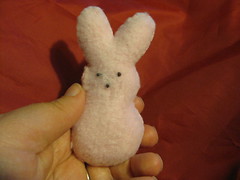Materials:
- Fleece or felt
- Matching embroidery floss
- Brown embroidery floss
- Some kind of fluff
- A nice, sharp needle
Download a PDF version of these directions
You can use fleece or felt. I'm using fleece here for 3 reasons. 1) I already had the colors and I'm practical like that, 2) Fleece is a little more flexible, especially with the chicks that have to be twisted around so much, and 3) I like a soft yellow color for my chicks and most of the yellow felts available are really garish.
Fleece Note: Fleece usually comes REALLY wide. Unless you are a crazy chicken-making fool, I can't imagine that you will need more than a 1/4 of a yard. you can probably get away with less, even.
Cut out your shape out. Note that some fleece is fuzzier on one side than the other. Decide which side you want facing out.
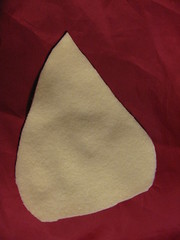
Fold it in half and start sewing at the pointy (beak) end. Load your needle with your matching floss. I typically use 3 of the 6 threads. Make it long enough to do everything in one fell swoop.
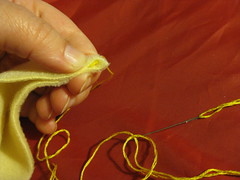
Blanket stitch from this end for about 2" down (go a little further than this picture shows). See my earlier post on blanket stitch for a video on how to do it. Stuff the head now, while it's easier to access.
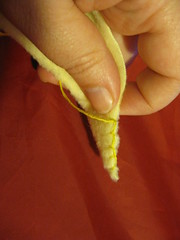
Finish blanket stitching down to the end and little bit around the curve.
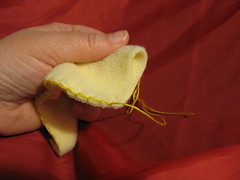
Finish stuffing.

Fill it up, but not so much that it isn't flexible enough to bend.
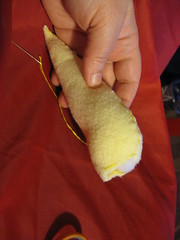
Drawstring the hold by weaving the needle in and out.


When you pull it taut, it creates a nice chicken bum effect.
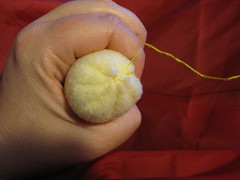
Cross the needle back and forth a few times from different angles to lock it all in. Knot it off, but don't cut the thread.
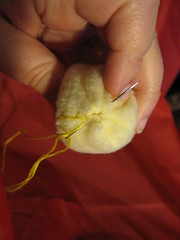
Practice bending the chick into shape. There are 4 parts.
Beak - The tiny end bit. Do not sew down
Head - The top part. You might want to play around with the stuffing a tad to make the head more "headish."
Neck - The middle part
Body - The big bottom part
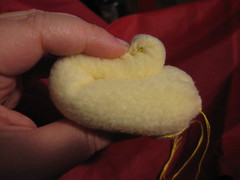
Basically we are going to sew everything down at the same time.
Go up through the drawstring closure and out through the middle of the back. Go through the chick's neck, up into and across the chin and out the other side. Try pulling the thread and you'll see it fold up nicely.
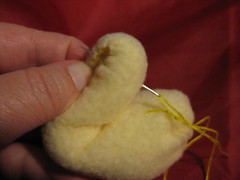
Now, go back down through the neck to the back.
Assess your chick. I generally find that the neck isn't attaching back far enough. Pull the floss snug and then make a second back to neck to head to neck to back loop to anchor it down better.
Tie off your floss and hide your knot between the back and neck.
Use your brown embroidery floss to add French knot eyes and nose. Hide your knots up under the chin. See my earlier post for a video on how to tie them.
Your finished chick!

